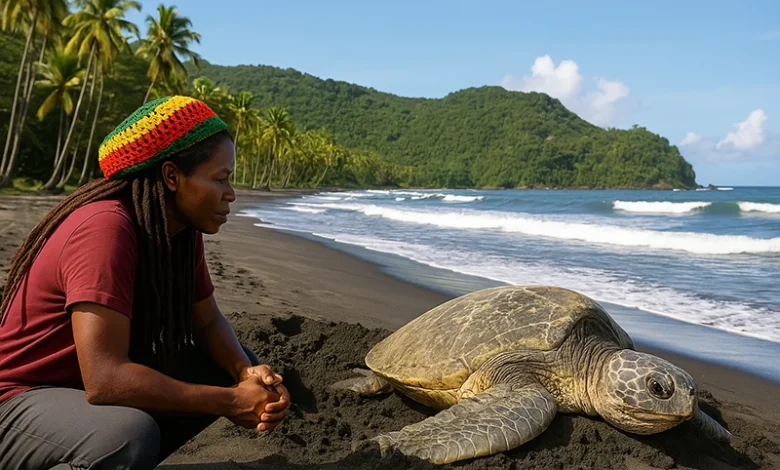Green Turtles in Dominica

Green turtles (Chelonia mydas) are a vital part of Dominica’s marine biodiversity, frequently spotted in coastal waters and using the island’s beaches as nesting grounds. Named for the greenish color of their body fat, these gentle herbivores contribute to the health of seagrass beds and coral reef ecosystems, playing an essential ecological role in Dominica’s ocean environment.
Green Turtles’ Physical Characteristics and Behavior
Green turtles typically reach lengths of 3 to 4 feet and can weigh up to 400 pounds. Unlike many other sea turtles, adults primarily feed on seagrasses and algae, which contribute to the distinctive color of their fat. They are known for their long migrations between feeding and nesting grounds, and have strong nesting site fidelity, returning to the same beach where they were born to lay their eggs.
Nesting in Dominica
Green turtles nest on several of Dominica’s beaches, particularly from June to October, with peak nesting occurring in July and August. Key nesting beaches include:
- Rosalie Bay – on the east coast, a popular nesting site also known for turtle conservation initiatives
- Bout Sable Beach – located in La Plaine, monitored by local conservation groups
- Cabana Bay and Londonderry – on the northern coast, often used by both green and leatherback turtles
At night, female turtles crawl ashore to dig nests and deposit eggs, an awe-inspiring natural event often witnessed by eco-tourists under guided supervision.
Threats and Conservation Challenges
Green turtles face several significant threats that have led to their classification as endangered under the IUCN Red List:
- Habitat Loss: Coastal development, especially near nesting beaches, reduces safe nesting areas and leads to light pollution that can disorient hatchlings.
- Illegal Harvesting: Despite legal protections, poaching for meat, eggs, and shells continues to pose a problem in isolated areas.
- Fishing Gear Entanglement: Incidental capture in nets and longlines remains a major cause of injury and mortality.
- Marine Pollution: Ingestion of plastics and exposure to oil or chemical spills harms turtles and degrades their feeding grounds.
Conservation in Action
Dominica has made commendable strides in sea turtle conservation, particularly through the following efforts:
Community-Based Programs
Groups like the DomSeTCO (Dominica Sea Turtle Conservation Organization) monitor nesting beaches, tag turtles, and educate communities about the importance of turtle conservation. Their presence has led to increased hatchling survival rates and better local engagement in environmental protection.
Eco-Tourism Integration
Resorts such as Rosalie Bay Eco Resort offer turtle conservation experiences for visitors. These programs include early morning hatchling releases, guided night walks during nesting season, and educational sessions that raise awareness about sea turtle lifecycles and threats.
Government and NGO Collaboration
National legislation protects endangered sea turtle species and their nesting sites. Collaborative efforts between the Ministry of Environment, fisheries officers, and NGOs have helped enforce laws and support data collection on nesting trends.
A Future for Green Turtles in Dominica
Green turtles are more than just a tourist attraction—they are indicators of ocean health and symbols of marine conservation success. Their continued survival in Dominica depends on collective efforts that span community activism, legislative enforcement, scientific research, and sustainable tourism.
Protecting green turtles ensures Dominica maintains its standing as a nature island where wildlife, people, and ecosystems coexist. Locals and visitors can contribute to safeguarding these endangered giants of the sea by supporting conservation initiatives and practicing eco-friendly behaviors.




